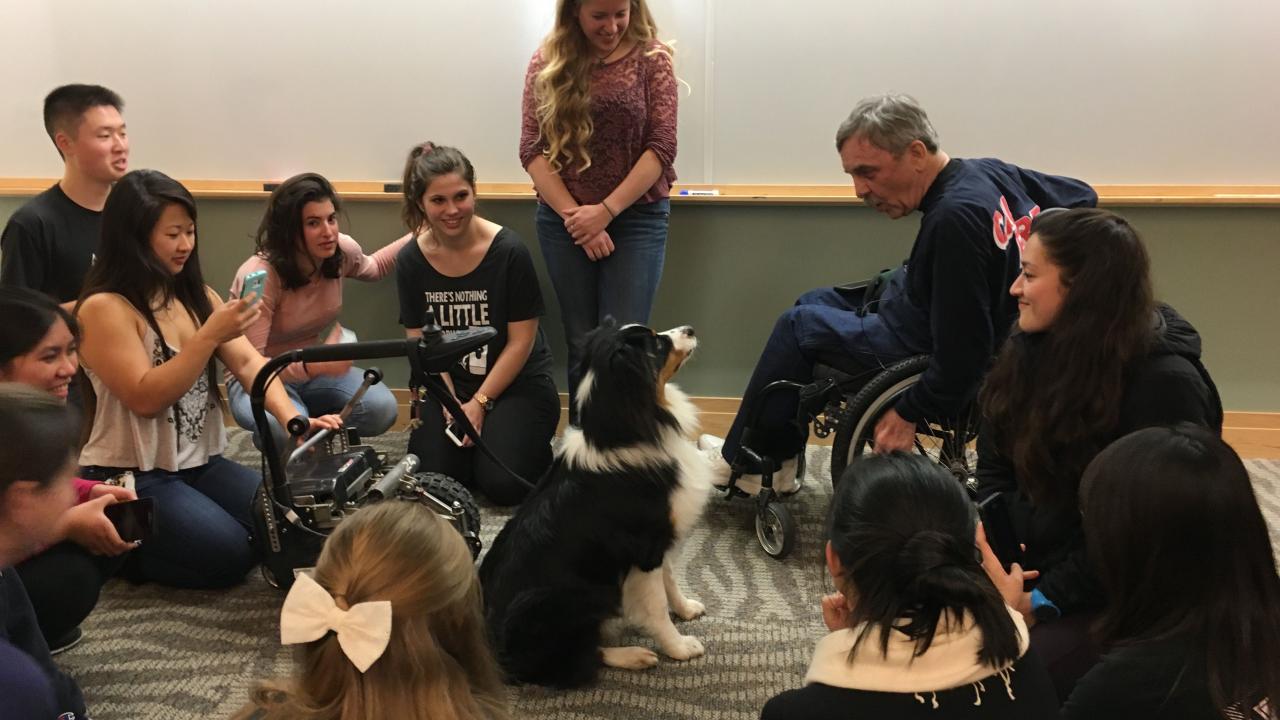Quick Summary
- People think of service dogs as helping those with visible disabilities
- Dogs help autistic children, diabetics, those who get seizures
Dogs have helped people who are blind and who have other physical disabilities for hundreds and even thousands of years, but they are increasingly helping people with mental health and otherwise invisible disabilities to meet life’s challenges, a University of California, Davis, study has found.
Psychiatric uses are the fourth most common use of service dogs in North America, ranking behind guide dogs for the blind, service dogs for mobility and those for the hearing-impaired. Dogs are increasingly being used for autistic children, diabetics, people who experience seizures and for other uses.
“Service dogs are a natural,” said Lynette Hart, who co-authored the study and teaches classes on service dogs at UC Davis. “There is a growing use of psychiatric service dogs for people with post traumatic stress disorder, as well as dogs for families with an autistic child, and also emotional support dogs,” said Hart, a professor in the Department of Population Health and Reproduction in the School of Veterinary Medicine. She is also a fellow in the International Society for Anthrozoology.

But the laws and policies guiding the use of these dogs in public places is varied, with the federally regulated airline industry and Housing and Urban Development having some of the most liberal policies in the types of animals that are acceptable. The Department of Justice, the military and Department of Veterans Affairs have stricter policies. Overall, U.S. laws and regulations pertaining to service dogs are “minimally” enforced, according to the paper.
“While taking a guide dog or mobility dog into a public place, airplane or train to help the disabled owner has generally been accepted because of the obvious need for the dog, there can be issues with regard to taking other types of assistance dogs … (into public places),” according to the study, which is co-authored by veterinary medicine and statistics researchers at UC Davis as well as Teikyo University of Science in Japan.
The study was published early this year in Frontiers in Veterinary Science.
In addition to Hart, UC Davis co-authors are Sandra Walther, Abigail Paige Thigpen, and Anaissa Garcia, Department of Population Health and Reproduction, School of Veterinary Medicine; and Neil H. Willits, Department of Statistics.

“Placement of these dogs for these new roles continues to expand, and California has been a pioneer to a great extent,” Hart said. Recent U.S. court cases have explored legal ways to use service dogs, as well. The U.S. Supreme Court earlier this year sided with a Michigan girl who used a service dog to help with her cerebral palsy disabilities, but was told by her school she could not bring her service dog to class. The ruling, sending the case back to an appeals court, makes it easier for students like her to seek redress for discrimination in federal court.
Service dogs complete many tasks and services
The value of guide dogs goes beyond the tasks they can complete for the owner — which can range from acting as their eyes and ears, to opening doors and turning on lights, to detecting cancer, the paper said. “They also promote self confidence, peace of mind, greater independence, a sense of safety, and enhanced social interaction.”
Researchers in the study looked mostly at dogs placed by Assistance Dogs International or the International Guide Dog Federation, accredited facilities that train and breed assistance dogs. But researchers also contacted private trainers and other organizations that place dogs. In private organizations, dogs for psychiatric assistance accounted for the most placements, according to the study.
According to data collected by researchers, more than 4,000 service dogs were placed in the United States in 2013-14, the latest figures available. The numbers were collected from accredited and unaccredited placement services on a voluntary basis.
Prior to the 1980s, most service dogs were used for the vision- or hearing-impaired only, according to the paper. New service roles continued to grow, in particular, after 2001.
A forthcoming conference at UC Davis June 22-27 will highlight uses of service dogs for children who have special needs, including autism.
This is one in a series of stories produced for Mental Health Awareness Month illustrating how UC Davis plays an active role in research, treatment and recognition of mental health issues.
Media Resources
Karen Nikos-Rose, UC Davis News and Media Relations, 530-219-5472, kmnikos@ucdavis.edu
